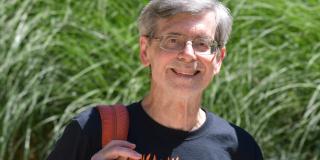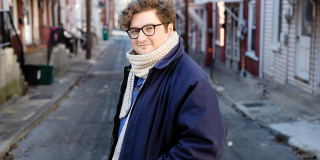
Quilting has a centuries old tradition. People in nearly every part of the world have used padded fabrics for clothing and bedding. The quilt, as we know it in America, was originally a utilitarian article, born of the necessity to provide warm covers for beds, but quilting is an art form being explored by artist Anna Chupa.
Chupa, associate professor and chair of art, architecture, and design, uses a longarm quilting machine to create works inspired by Islamic architecture. She designs whole cloth quilts, where a single piece of fabric is used for the top layer, and the key decorative element is likely to be the pattern of stitching. Chupa typically produces works measuring approximately 25 inches by 36 inches.
“Instead of the traditional pieced quilt, I create whole cloth quilts from my textile designs,” says Chupa. “I can use the automated process with stitchery I have designed so that every step of the process from the fabric to the quilting is my design.”
Her tiling designs are inspired by building tiles found in southern Spain. From photographs she takes of architecture, flowers and foliage, she extracts object details and montages them into still life compositions, embedding them into tiles found in Islamic building design. Still life pattern groupings are set into the tiles, which are then arranged in a composition that is bilaterally symmetrical, but nonperiodic. Her designs reinforce lines of symmetry as a kind of interlace design and define fivefold symmetries as the patterns unfold, Chupa adds.
“I take the tiles, which are flat color and I fill the tiles with the patterns, then fill an area by digitally piecing together many tiles, producing a whole cloth quilt.”
At close viewing distances, the floral forms are visible and distinct, but these dissolve into the broader context of geometric pattern at more typical viewing distances, consistent with the aesthetic of dematerialization in Islamic architecture. These tiles are created using graphic design software. Chupa then uses Art and Stitch software, which enables her to convert these graphic elements into stitches. At that point, the stitching can be automated by the computer on the longarm machine. The machine can be used for either hand-guided or computer-guided quilting and is powerful enough to pierce the thick sandwiched rolls of fabric backing, batting and quilt tops as the quilt is being stitched. The machine head is mounted on a twelve-foot table with take-up rollers for the rest of the fabric, and Chupa moves the sewing head across the fabric.
The longarm allows her to “paint” with thread, sequins and a technique called couching. Couching gives a quilt texture by using a stitch that allows fibers to be added onto the surface of the quilt. The result is a dense surface resembling embroidery.
Chupa sees her creative work transferring to the classroom. She envisions offering a textile course in the future stemming from her work in the quilting studio.
“I think there’s great potential to offer something that is interdisciplinary and would bring in students from other departments like theatre. We’ve never offered a textile course and it will be exciting to expose students to this art form.”
-Robert Nichols






